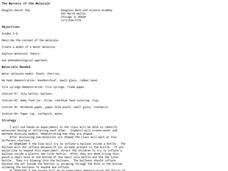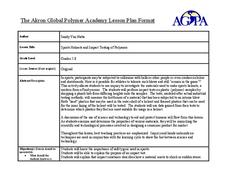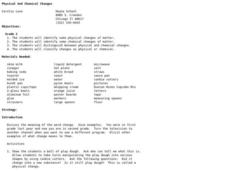Curated OER
How do they make glass into different shapes?
Students investigate the process of glass blowing.For this simulation of glass blowing experiments students experiment how glass is formed and why not all glass is the same.
Curated OER
Mind-Blowing Glass
Students explore and study the life and art of internationally know glass sculptor, Dale Chihuly. They recognize organic forms in her massive body of blown-glass work and create an organic sculpture of their own utilizing her style of...
Curated OER
Glass Blowing How Do They Make Glass Into Different Shapes?
Students experiment with butter as a supercooled liquid in order to better explain how glass is made into different shapes.
Curated OER
More on Conduction and Convection
Why do some items feel colder when they are the same temperature? How should you keep your soda cold? What makes the wind blow? These are just some of the things middle schoolers discover when completing a lesson on...
Curated OER
Marine Debris
Students perform experiments to examine if debris float, or blow in the wind. The effects of these characteristics on the marine debris are then discussed. They determine how a material can influence what becomes marine debris.
Curated OER
Sound/Pitch
Students explore how pitch changes when using instruments that are plucked, blown, and hit. In this sound and pitch lesson, students blow across the top of bottles that are filled with water to create sound. Students use recorders...
Curated OER
The Marvels of the Molecule
Students experiment with common substances to observe molecular behavior. In this molecular properties lesson, students move through four stations as they try to inflate a balloon inside a bottle, pour water from a jar, and observe how...
Curated OER
Hillary Clinton's Record, Through the Looking Glass
Students assess how images and words in a political ad deliver its message and stir the emotions in the general public. They research information that supports or refutes claims made in the ad as well as the credibility of the ad. Each...
Curated OER
Is It Breathable?
Students explore air quality. In this environmental lesson plan, students observe a simulation of air pollution by blowing into a jar (with a straw) that has chalk dust. Students discuss how air quality can effect the way we breathe.
Curated OER
Trash Traits: Marine Debris, Litter, Ecology, Oceans
Students perform experiments to examine whether trash can float, blow around, or wash away. The effects of these characteristics on the presence of marine debris in the environment are then discussed.
Curated OER
Marine Debris
Students will perform experiments to examine if debris will float, or blow in the wind. They discuss the effects of these characteristics on marine debris.
Curated OER
Water Cycle Lesson Plan
After conducting experiments with a sponge, ice water, and a soda bottle your young scientists become familiar with the water cycle through experiment, song, hand motions and drawing. Students sing about the water cycle and discuss...
Beyond Benign
Product Test
It's the moment of truth. Previous lessons in the 24-part series had scholars design and develop shampoo formulas using chemical concepts. The 18th activity asks them to test the function of their shampoos. To do this, they calculate the...
Curated OER
Take a Deep Breath: Air Today, Air Tomorrow
This is the introductory lesson in a series about air quality. Why is it so important that we breathe clean air? How can we make sure we're keeping our air clean? A discussion is the central idea of the lesson, and example questions are...
Curated OER
Dialogue: Travel
In this travel dialogue worksheet, students read aloud in pairs a dialogue about travel.
Curated OER
Marine Debris
Now is the time to educate tomorrow's citizens to care for the planet, and here is a lesson to help facilitate the process. Collect some marine debris and bring it into class. Have your class separate it into types and then test each...
Curated OER
Air, Air-It's Everywhere!
Pupils engage in experiment activities, which illustrate that air is made of matter, does take up space, and is very important to our health. This lesson contains activities for a variety of grade levels. A very nice idea!
Curated OER
Water Changes and Moves
Students explore the three forms of water and observe how it changes from a solid to a liquid to a gas. The concepts of condensation, evaporation and the introduction to the water cycle form the basis of this instructional activity.
Curated OER
Where Does Al the Waste Go?
Young scholars construct a sanitary mini-landfill and an open mini-dump. Over a thirty day period, they compare the two methods and determine landfills are envorinmentally safer. They observe a demonstration of burning waste. They create...
Curated OER
In the Rain Shadow
Students, while utilizing a large wall map, experiment recording the annual precipitation for cities on the east and west sides of the Cascade Mountains. They discover that volcanic mountains do not have to erupt to affect the atmosphere.
Teaching English
Fairy Tales; Not Just for Kids
"Once upon a time . . ." Language learners examine the key elements of well-known fairy tales and then craft their own.
Curated OER
Wind and Currents
Students observe how wind generates currents and the effect of islands and banks on currents. They determine ocean circulation affects climate and plant and animal populations on land and in the ocean and that surface currents are...
Curated OER
Sports Helmets and Impact Testing of Polymers
Students examine the importance of good quality safety gear. In this investigative lesson, students will tests various polymers, collect data, and analyze the data to determine which polymer is best for safety helmets. They will design a...
Curated OER
Physical And Chemical Changes
Second graders identify physical and chemical changes of matter. They distinguish between physical and chemical changes. They classify changes as physical or chemical.

























